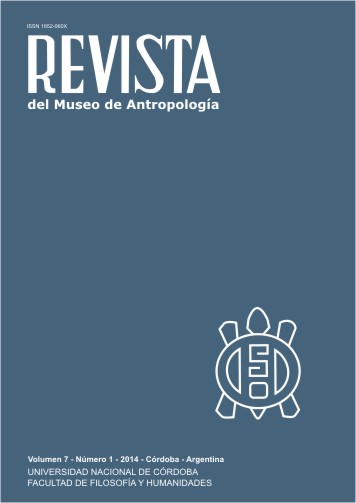Rivalries and alliances networks among supporter’s groups in Argentina
DOI:
https://doi.org/10.31048/1852.4826.v7.n2.9189Keywords:
soccer, sport rivalry, alliances, supporters, social network analysisAbstract
In order to evaluate the influence of factors such as frequency of matches played and the geographic proximity of sports institutions in the establishment of rivalries and alliances between soccer supporters, I developed a social network analysis using a dataset for 186 Argentinian hinchadas . The data set includes rivalry’s network (rivalries mutually recognized), alliance’s network (mutually recognized affinities and alliances) and interaction’s network (amount of matches played in the last 40 years), and provincial and municipal adscription attributes (location of stadium). The results show that the regional-national organization of sports competition, in its 5 competitive levels (First A, National B, First B, First C, First D, A, B and C) affects the structure of the rivalry’s network and alliance’s network between adherents of Argentine football teams. In addition I detected a significant, but smaller, presence of balanced triads of two enemies and one friend that allow to identify a “logic of the common enemy.”Downloads
References
AAVV. 2006. Estudio sobre adhesiones a equipos de fútbol. Total país marzo 2006, Equis, Buenos Aires.
Alabarces, P. 2004. Crónicas del aguante: fútbol, violencia y política, Capital Intelectual, Buenos Aires.
Alabarces, P., R. Coelho, J. Garriga Zucal, B. Guindi, A. Lobos, M. V. Moreira, A. Szrabsteni. 2000. “Aguante” y represión. Fútbol, violencia y política en la Argentina.
Alabarces, P., Peligro de gol. Estudios sobre deporte y sociedad en América Latina, 6, 211-230, CLACSO, Buenos Aires.
Bundio, J. S. 2011a. Conflictos y alianzas entre hinchadas argentinas: apuntes metodológicos para el testeo de hipótesis mediante Análisis de Redes Sociales. Lecturas Educación Física y Deportes, 16 (155): 1-1. http://www.efdeportes.com/efd155/conflictos-y-alianzas-entrehinchadas-argentinas.htm, última consulta: 19/03/2013
Bundio, J. S. 2011b. Duelo en las gradas. La ideología de grupo desplegada en el canto de una hinchada de fútbol, Editorial Académica Española, Saarbrücken.
Bundio, J. S. 2012. “El enemigo de mi enemigo es mi amigo”. Explorando los conflictos y las alianzas entre hinchadas de fútbol. Lecturas Educación Física y Deportes, 15(167): 1-1. http://www.efdeportes.com/efd167/alianzas-entre-hinchadas-de-futbol.htm, última consulta: 19/03/2013.
Garriga Zucal, J. 2002. “Amistades entre hinchadas”. Violencia, masculinidad y vínculos de amistad de un grupo de simpatizantes del fútbol argentino. Lecturas Educación Física y Deportes, 8(55): 1-1. http://www.efdeportes.com/efd55/hinchada.htm, última consulta: 19/03/2013.
Garriga Zucal, J. 2005a. Pibitos chorros, fumancheros y con aguante. El delito, las drogas y la violencia como mecanismos constructores de identidad en una hinchada de fútbol. Alabarces, P., Hinchadas, 2, 59-74, Prometeo Libros, Buenos Aires.
Garriga Zucal, J. 2005b. “Soy Macho porque me la aguanto”. Etnografía de las prácticas violentas y la conformación de identidades de género masculino. Alabarces, P., Hinchadas, 2, 39-58, Prometeo Libros, Buenos Aires.
Garriga Zucal, J. 2007. Haciendo amigos a las piñas: violencia y redes sociales de una hinchada de fútbol, Prometeo Libros, Buenos Aires.
Hanneman, R.,M. Riddle. 2005. Introduction to social network methods, University of California, Riverside.
Moreira, M. V. 2001. Aguante y Honor: la visión nativa. Lecturas Educación Física y Deportes, 7(36): 1-1. http://www.efdeportes.com/efd36/aguante.htm, última consulta: 19/03/2013.
Moreira, M. V. 2005. Trofeos de guerra y hombres de honor. Alabarces, P., Hinchadas, 3, 91-104, Prometeo Libros, Buenos Aires.
Moreira, M. V. 2007. Etnografía sobre el honor y la violencia de una hinchada de fútbol en Argentina. Revista Austral de Ciencias Sociales, 13: 5-20.
Reynoso, C. 2008. Hacia la complejidad por la vía de las redes. Nuevas lecciones epistemológicas. Desacatos. Revista de antropología social, septiembre-diciembre, 28: 17-40.
Reynoso, C. 2011. Redes y complejidad: modelos interdisciplinarios en la gestión sostenible de la sociedad y la cultura, Sb, Buenos Aires.
Watts, D. 2006. Seis Grados de Separación. La Ciencia de las Redes en la Era del Acceso, Paidós Ibérica, Barcelona.
Downloads
Published
Issue
Section
License
Those authors who have publications with this Journalaccept the following terms:
a. Authors will retain their copyrights and guarantee the journal the right of first publication of their work, which will be simultaneously subject to the Creative Commons Attribution License (Licencia de reconocimiento de Creative Commons) that allows third parties to share the work as long as its author and his first publication in this journal.
b. Authors may adopt other non-exclusive licensing agreements for the distribution of the version of the published work (eg, deposit it in an institutional electronic file or publish it in a monographic volume) provided that the initial publication in this journal is indicated.
c. Authors are allowed and recommended to disseminate their work on the Internet (eg in institutional telematic archives or on their website) before and during the submission process, which can lead to interesting exchanges and increase citations of the published work. (See The Effect of Open Access - El efecto del acceso abierto)












